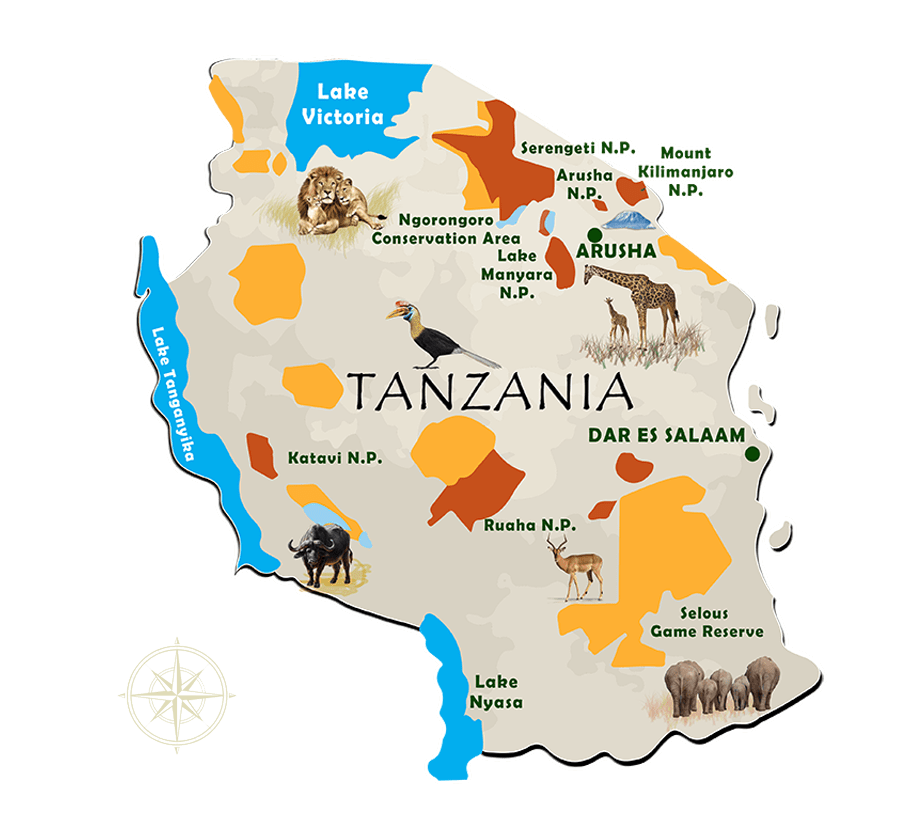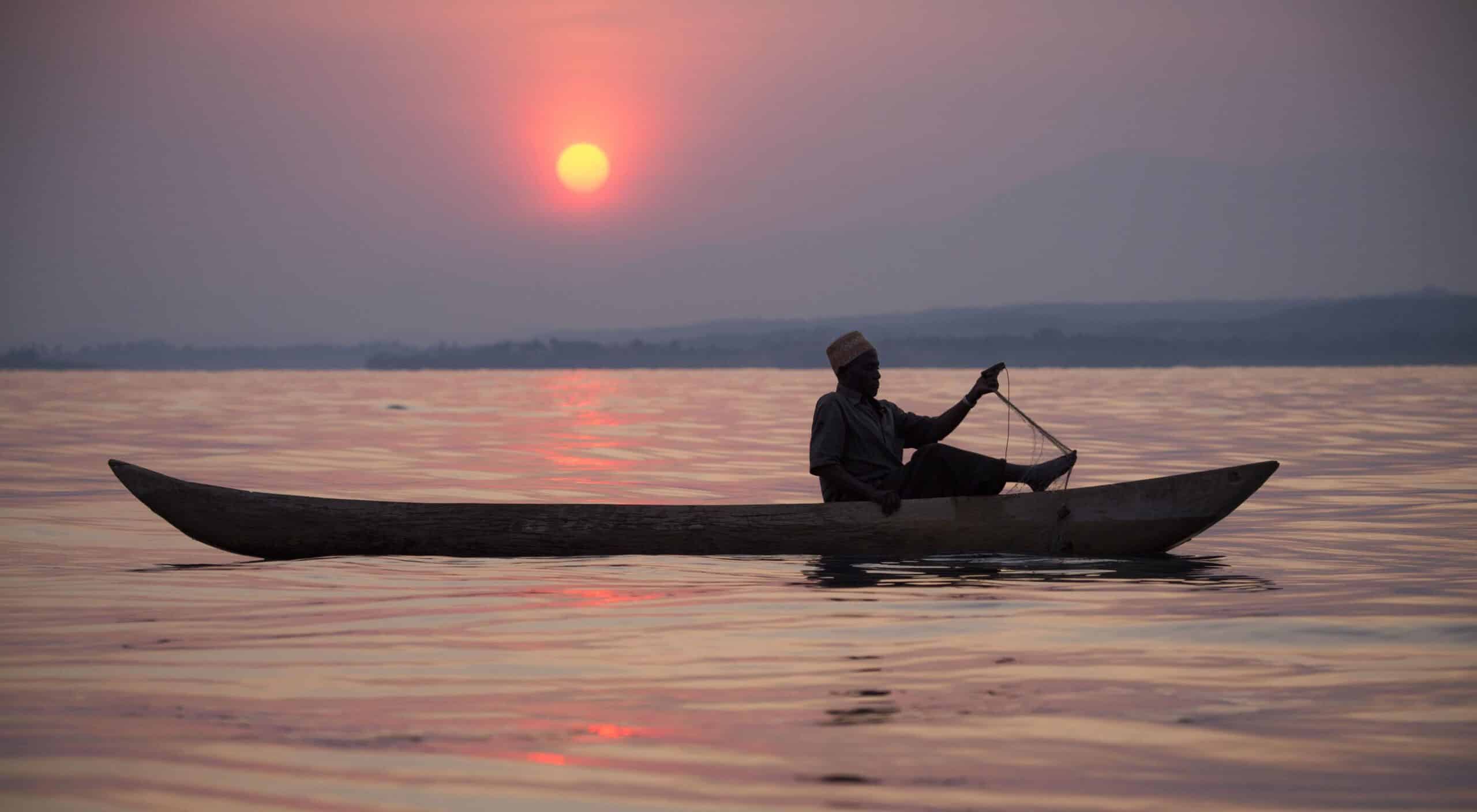
Western Tanzania

32,900 km²

Freshwater lake with rich biodiversity

Stunning shoreline with natural hot springs
Lake Tanganyika is renowned for its crystal-clear waters and abundant wildlife, offering a tranquil yet exciting escape for nature lovers. As the second deepest lake in the world and one of the oldest, it spans four countries—Tanzania, Burundi, Democratic Republic of Congo, and Rwanda—and serves as a unique biodiversity hotspot.
Lake Tanganyika stretches over 32,900 square kilometers (12,700 square miles), making it the largest freshwater lake in Africa by volume. The lake’s shoreline features lush rainforests, rugged mountains, and secluded bays, creating a diverse landscape that is perfect for both relaxation and exploration. Visitors can take in the stunning views of the shimmering blue waters set against the backdrop of towering cliffs and tropical vegetation.
The lake is home to an incredible variety of species, both in its waters and surrounding ecosystems. Endemic fish species like the colorful cichlids, and freshwater dolphins, inhabit its depths, making it a prime destination for underwater enthusiasts. On land, the shores of Lake Tanganyika offer a chance to spot a range of wildlife, including primates, hippos, and exotic bird species. These sightings are a testament to the region’s thriving biodiversity and a draw for wildlife enthusiasts.
The basin of Lake Tanganyika is known for its rich ecosystems, including diverse habitats along the lake’s shores. The surrounding forested areas offer opportunities for hiking and exploring, where visitors can enjoy lush vegetation and spot rare species. In addition, the lake’s waters provide abundant fishing opportunities, supporting local communities and offering a glimpse into the region’s way of life.
For those seeking privacy and a more personalized experience, the shores of Lake Tanganyika offer private lodges and exclusive resorts that provide intimate views of the lake. These remote locations offer a peaceful retreat for those looking to immerse themselves in the natural beauty of the area, without the hustle and bustle of more crowded tourist spots.
Lake Tanganyika also holds a wealth of cultural and historical importance, with local tribes such as the Bemba and the Hutu offering a unique glimpse into the traditions and lifestyles of the region. Visitors can explore local villages, learn about ancient customs, and even participate in traditional fishing practices that have been passed down through generations.
Whether you’re cruising across its tranquil waters, trekking through its forests, or simply relaxing by its serene shores, Lake Tanganyika offers a remarkable eco-tourism experience. With its rich natural beauty, abundant wildlife, and fascinating cultural heritage, it stands as a pristine, off-the-beaten-path destination that promises to leave travelers in awe.
For me, Lake Tanganyika offers one of the most unique and breathtaking experiences in Africa. Its stunning combination of clear blue waters, lush landscapes, and diverse wildlife makes it a haven for nature enthusiasts and adventure seekers alike. The lake’s tranquil beauty, nestled between towering mountains and tropical forests, provides an unforgettable setting for exploration. One of my most cherished memories was watching freshwater dolphins leap gracefully in the lake, with the distant sounds of nature surrounding me—a rare and mesmerizing sight.

Travel Designer
Browse through some of the finest accommodation options

However, we’ll plan your safari around your interests, tastes, and preferences. In addition, we provide honest advice based on first-hand knowledge. Moreover, our goal is to ensure that every aspect of your journey reflects what you truly enjoy. Therefore, you can expect a customized experience that caters specifically to your desires. Furthermore, our expertise will guide you in making the most informed decisions. Ultimately, this approach guarantees a memorable and fulfilling travel experience, ensuring exceptional service, personalized attention, and unique opportunities for adventure.

However, our expert guides and brilliant concierges are hand-picked for their ability to bring your destination to life with care and passion. Furthermore, their extensive knowledge and enthusiasm ensure that every moment of your journey is enriched with local insights. Moreover, they are dedicated to providing an exceptional experience tailored to your preferences. As a result, you can fully immerse yourself in the destination and enjoy a truly unique adventure. Ultimately, their commitment transforms your trip into an unforgettable exploration of the world.

But, we seek out unforgettable experiences that benefit both local communities and the environment. By doing so, we ensure that your adventures not only create lasting memories but also positively impact the places you visit. Additionally, our focus on sustainability and community support helps preserve the natural beauty and cultural heritage of the destinations. Ultimately, this approach allows you to enjoy your journey while contributing to the well-being of both people and the planet, ensuring sustainability, cultural respect, and environmental preservation throughout your travels.
Hence, get inspired by our example trips, and then reach out to plan your adventure. Whether you have specific desires or need guidance, our team of expert travel designers is ready to help. Additionally, we tailor each trip to meet your unique interests and preferences. Therefore, you can be assured of a personalized and exceptional travel experience. Ultimately, we are here to make your dream journey a reality.
Therefore, whatever you want from your tours, our team of expert travel designers are ready to help.

Home Made For You Highlights Where to stay Trip inspiration Where to go When to visit Inspiration Location Area 988 km² Ecosystem Coral Reefs Unique Feature Spice Farms Experience a Tropical Escape on Pemba Island…
All Destination Mount Kilimanjaro Climbing National Parks,Mountain Range 1668 km² Northern Circuit, Kilimanjaro Book OverView Highlights Activities FAQ Safari Packages Parks Nearby Mount Kilimanjaro National Park National Parks,Mountain Range 1668 km² Northern Circuit, Kilimanjaro Mount…
All you need to know about Kilimanjaro National Park Reading time: 6 minutes Oct 16, 2024 A Treasured Landmark The Park is one of Tanzania’s most treasured landmarks and a top destination for visitors. Discover…
Home Made For You Highlights Where to stay Trip inspiration Where to go When to visit Inspiration Location Area 70 meters (approx.) Ecosystem Lush Tropical Forest Unique Feature Coffee Tours Nearby Experience a Refreshing Adventure…
Home Made For You Highlights Where to stay Trip inspiration Where to go When to visit Inspiration Location Area 1,510 km² Ecosystem Savanna and riverine forests Unique Feature The Great Migration Experience a Thrilling Safari…
Where History Meets Exotic Beaches Welcome to Sun, Sand and Spice Zanzibar Island: A Tropical Sanctuary Nestled off Tanzania’s coast in the warm waters of the Indian Ocean, Zanzibar Island provides an unparalleled experience for…
Home Made For You Highlights Where to stay Trip inspiration Where to go When to visit Inspiration Location Area 1,990 km² Ecosystem Montane and tropical rainforests Unique Feature Stunning waterfalls, including the Sanje Falls Experience…
The Land of 1000’s of Elephants Welcome to Home to the Elephants Tarangire National Park is renowned for its majestic Baobab trees, which can grow to an enormous size and boast a unique, iconic shape….
Home Made For You Highlights Where to stay Trip inspiration Where to go When to visit Inspiration Location Area 1,100 km² Ecosystem Coastal and Savannah Unique Feature Beach and Wildlife Combination Experience a Thrilling Safari…
Home Made For You Highlights Where to stay Trip inspiration Where to go When to visit Inspiration Location Area 456 km² Ecosystem Forest and Lake Shore Unique Feature boat safaris and primate sightings. Experience a…
Home Made For You Highlights Where to stay Trip inspiration Where to go When to visit Inspiration Location Area 14 km² Ecosystem Coastal and mangrove forests Unique Feature Historical Swahili architecture and pristine beaches Experience…
Home Made For You Highlights Where to stay Trip inspiration Where to go When to visit Inspiration Location Area 30,893 km² Ecosystem Miombo woodlands, savanna, rivers Unique Feature The Rufiji River and boat safaris Experience…








The best time to visit Lake Tanganyika depends on the experience you’re seeking. The dry season, from June to October, is ideal for enjoying the lake’s stunning scenery and engaging in water-based activities like boating and fishing. During this period, the weather is more comfortable, with less rainfall and pleasant temperatures, providing a great opportunity to explore the surrounding landscapes. It’s also a fantastic time to spot wildlife along the shores, as animals tend to gather near water sources.

June-October

November to May
Whatever you want from your adventure in the Tanzania, our team of expert travel designers are ready to help


Therefore, when you book a safari in today’s world, there is much to consider. However, with the right advice and expert planning, you can confidently approach your travel arrangements. Additionally, our experienced team is here to provide guidance. In other words, we ensure that every detail is handled smoothly.
Moreover, if you book to travel with us, your plans are impacted by circumstances beyond your control, then we understand that flexibility is essential. Consequently, we offer options to adjust your reservation or cancel it. As a result, you will receive full credit for future travel expenses. Thus, you can plan your next adventure without worry.
Lake Tanganyika is known for being the second deepest lake in the world and the largest freshwater lake in Africa by volume. It is renowned for its rich biodiversity, particularly its endemic fish species, including colorful cichlids, and its serene, picturesque landscapes.
Lake Tanganyika is located in East Africa and borders four countries: Tanzania, Burundi, the Democratic Republic of Congo (DRC), and Rwanda. It spans over 32,900 square kilometers and offers diverse cultural and natural experiences across its shores.
Visitors to Lake Tanganyika can enjoy a variety of activities such as boat safaris, fishing, snorkeling, and scuba diving. The lake is also ideal for birdwatching, hiking around its shores, and exploring local villages for a taste of the region’s culture and traditions.
The best time to visit Lake Tanganyika is during the dry season, from June to October, when the weather is pleasant and the water is calm for outdoor activities. However, the green season, from November to May, offers lush landscapes and vibrant birdwatching opportunities, making it a great time for nature lovers.